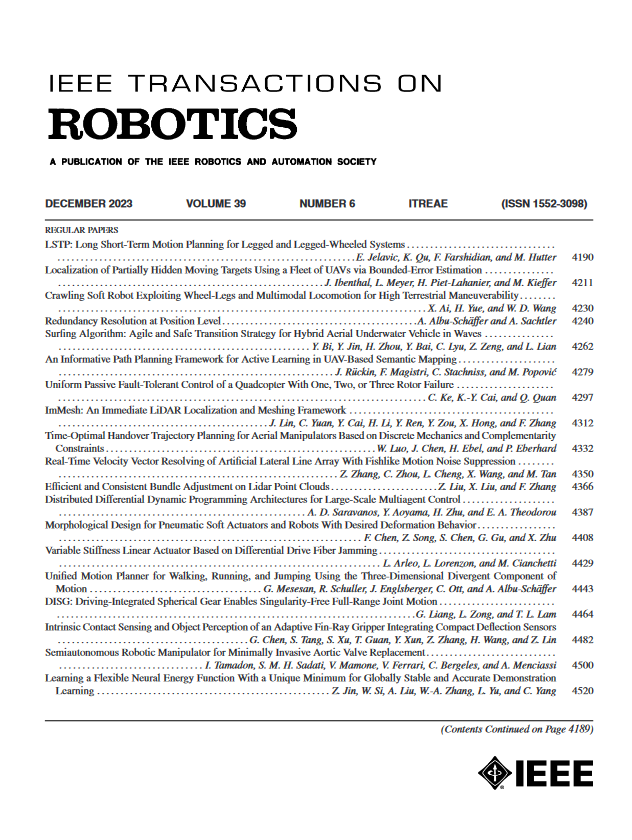Augmented Maximum Correntropy Criterion for Robust Geometric Perception
IF 9.4
1区 计算机科学
Q1 ROBOTICS
引用次数: 0
Abstract
Maximum correntropy criterion (MCC) is a robust and powerful technique to handle heavy-tailed nonGaussian noise, which has many applications in the fields of vision, signal processing, machine learning, etc. In this article, we introduce several contributions to the MCC and propose an augmented MCC (AMCC), which raises the robustness of classic MCC variants for robust fitting to an unprecedented level. Our first contribution is to present an accurate bandwidth estimation algorithm based on the probability density function (PDF) matching, which solves the instability problem of the Silverman's rule. Our second contribution is to introduce the idea of graduated nonconvexity (GNC) and a worst-rejection strategy into MCC, which compensates for the sensitivity of MCC to high outlier ratios. Our third contribution is to provide a definition of local distribution measure to evaluate the quality of inliers, which makes the MCC no longer limited to random outliers but is generally suitable for both random and clustered outliers. Our fourth contribution is to show the generalizability of the proposed AMCC by providing eight application examples in geometry perception and performing comprehensive evaluations on five of them. Our experiments demonstrate that 1) AMCC is empirically robust to 80%用于稳健几何感知的增量最大熵标准
最大熵准则(MCC)是一种处理重尾非高斯噪声的稳健而强大的技术,在视觉、信号处理、机器学习等领域有着广泛的应用。在本文中,我们介绍了对 MCC 的几项贡献,并提出了增强 MCC (AMCC),它将用于鲁棒拟合的经典 MCC 变体的鲁棒性提高到了前所未有的水平。我们的第一个贡献是提出了一种基于概率密度函数(PDF)匹配的精确带宽估计算法,它解决了西尔弗曼规则的不稳定性问题。我们的第二个贡献是在 MCC 中引入了渐进非凸性(GNC)思想和最差剔除策略,弥补了 MCC 对高离群比的敏感性。我们的第三个贡献是提供了局部分布测量的定义来评估离群值的质量,这使得 MCC 不再局限于随机离群值,而是普遍适用于随机离群值和聚类离群值。我们的第四个贡献是提供了八个几何感知应用实例,并对其中五个实例进行了综合评估,从而展示了所提出的 AMCC 的通用性。我们的实验证明:1)根据经验,AMCC 对各种应用中 80%-90% 的随机离群值都具有鲁棒性,这比 Cauchy M-估计、MCC 和 GNC-GM 要好得多;2)AMCC 在聚类离群值中表现出色,在离群值达到 80% 时,其成功率比排名第二的方法高出 60%-70% 个百分点;3)AMCC 可以实时运行,在离群值比例较高的低维估计问题中,比 RANSAC 类方法快 10%-100 倍。这一差距会随着模型维度的增加而呈指数增长。
本文章由计算机程序翻译,如有差异,请以英文原文为准。
求助全文
约1分钟内获得全文
求助全文
来源期刊

IEEE Transactions on Robotics
工程技术-机器人学
CiteScore
14.90
自引率
5.10%
发文量
259
审稿时长
6.0 months
期刊介绍:
The IEEE Transactions on Robotics (T-RO) is dedicated to publishing fundamental papers covering all facets of robotics, drawing on interdisciplinary approaches from computer science, control systems, electrical engineering, mathematics, mechanical engineering, and beyond. From industrial applications to service and personal assistants, surgical operations to space, underwater, and remote exploration, robots and intelligent machines play pivotal roles across various domains, including entertainment, safety, search and rescue, military applications, agriculture, and intelligent vehicles.
Special emphasis is placed on intelligent machines and systems designed for unstructured environments, where a significant portion of the environment remains unknown and beyond direct sensing or control.
 求助内容:
求助内容: 应助结果提醒方式:
应助结果提醒方式:


